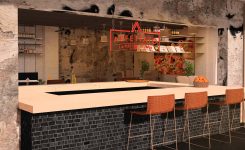Design Strategy, Trends
Tech and Design: What Does The Future Hold?
November 14, 2018 - Design Strategy, Trends
Twenty years ago we sat on the cusp of the mobile phone revolution. The advancement in technology at the time opened up endless possibilities for designers from various fields. From new possibilities for existing design disciplines – product designers for example – to entirely new design job profiles, like application designers, the design world was headed towards a new era.
Today we sit on the cusp of another revolution. Advancements in technology today are paving the way for virtual, augmented and mixed reality to become a part of everyday life. Where does this leave designers? What is the current scenario and going forward, what are the new roles where designers will be able to add tremendous value? What are the skills that designers should begin to hone?
In this article, we take a look at the overall scenario, and in the following week, we will take a specific look at certain industries, to see what the future could hold. If you are a designer, perhaps the time is ripe to ask yourself – Am I ready?
WHAT’S WHAT
In case you’re not absolutely familiar with the terminology, here’s a succinct explanation from Wikipedia that sums it up nicely:
Virtual Reality (VR) immerses users in a fully artificial digital environment.
Augmented Reality (AR) overlays virtual objects on the real-world environment.
Mixed Reality (MR) doesn’t just overlay, but anchors virtual objects to the real world and allows the user to interact with the virtual objects.

Besides our smartphones and tablets, hardware such as Google Glass and Microsoft HoloLens present us with a whole new range of possibilities. Coupled with this, is the soon-to-be-ubiquitous 5G and the yet-to-be-realised potential of IoT, which push the boundaries even further.
WHERE DO DESIGNERS FIT IN?
The obvious roles for designers are in the more areas of traditional design, like graphic design, user interface (UI) and user experience (UX) design.
But beyond this, more and more designers are finding a spot at the biggest decision making tables across organisations, and not just at those within the design sector. With design thinking as a process gaining more popularity, the huge value a designer can add in helping to arrive at truly impactful and viable solutions is being recognised.
Companies are putting designers at the head of the table…The user’s experience of technology these days is even more important than the tech itself. The UI is what distinguishes a product; a company. That’s one reason why designers are being employed across industries.
– Scott Belsky,
Chief Product Officer, Adobe
Co-founder, Behance
Venture design services that incorporate the design thinking framework, where problems are looked at from a macro level, and proposed design solutions are crafted from end user insights along with other factors in their environment, will come to play an important role.

An interdisciplinary approach that views the problem from various angles and seeks the inputs of experts from different disciplines will lead to the most comprehensively designed solutions. For example, when planning a commercial building, an architect would create a more effective design if he clearly understood the market segment he was designing for, the demographics of the area and the needs of each specific age group of the end users.
This would require intensive research and an in depth analysis by the architect, requiring him to go beyond his domain and should ideally be a collaborative effort with other experts, such as a social anthropologist or social psychologist.
Furthermore, venture design enabled through design thinking, allows the business to discover and tap into latent needs that the end user might not even realise he has, leading to a more comprehensive solution.
With technology evolving at a speed that’s hard to keep up with, organisations will have to integrate new solutions rapidly. Venture design helps firms focus on the right thing at the right time, to take advantage of opportunities when they arise and to constantly deliver meaningful solutions. It also addresses the need for adaptability and answering the “what ifs”, by providing pivot strategies that enable the business to move or change the direction of their solutions to better fit the end user’s requirements, as they evolve.
Designers who wish to be at the forefront of pathbreaking designs, will have to engage in continuous learning and experimentation, to be able to understand, manipulate and employ new technology optimally.
The designers of the future need to look beyond just their field of speciality and also remind themselves to understand things from the point of view of a layman using that product or service. Design, be it of a product, space, user experience or of an organisation can no longer be looked at in isolation, if it is to be truly impactful.
As a designer, are you ready for the impending revolution that is upon us?
What are your thoughts – we’d love to know in the comments below.













